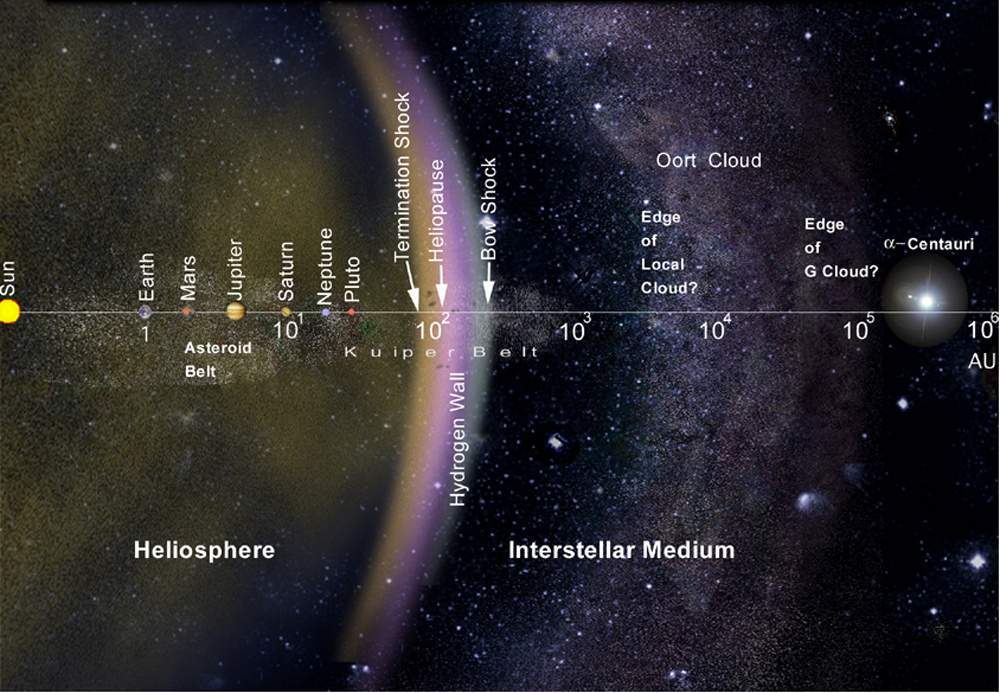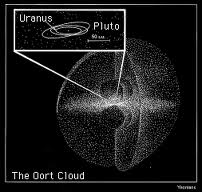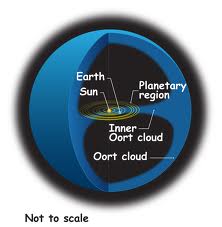
Humans generally like stability. We are used to our small, predictable world: Every 24 hours, we rotate on our axis; every 365 days, we revolve around the Sun. We have followed this pattern for millennia, and we will continue to follow this pattern for ages henceforth. For the most part, when we are thinking in cosmic terms, the Earth is steady and unchanging…but the same cannot be said for the rest of the solar system.

Chaos reigns 50,000 AU from Earth (1 AU is the distance between Earth and the Sun). At this icy distance, in the cold recesses of our solar system, we find the Oort cloud. At just over 4.6 trillion miles (7.4 trillion km) from the solar surface, the dense cloud is the hypothesized region at the outer edge of the Sun’s influence.
This portion of our neighborhood is nearly a quarter of the distance to Proxima Centauri, the nearest star to the Sun (which gives you some idea of just how far the Sun’s influence extends). Some scientists believe that you could travel half way to Proxima Centauri before you truly leave the Sun’s sphere of influence (meaning that you would have to essentially travel to the next star in order to leave our solar system).
This dark region of space is home to several trillion individual objects larger than 0.62 miles (1 km) and several billion with a diameter over 12 miles (20 km). This mass of material is believed to be the leftover remnants of the early solar system. Ultimately, this chaotic amalgamation of primordial material consists of whatever didn’t coalesce into planets, fall into the sun, or become a part of the asteroid belt that orbits between Mars and Jupiter.

Unlike the planets, which orbit (more or less) on the same plane of the solar system, the Oort Cloud is a dense smattering of material that envelopes the Sun. As you can see in the image, there is no rhyme or reason to the orbit of these icy bodies… There is no single, definitive orbit.
Rather, tidal interactions between the materials cause the pattern to constantly alter and shift, throwing some objects into the inner planetary region and slinging other objects out of the solar system entirely.
The objects in this cloud are grouped into two basic groups: short period comets and long period comets. Short period comets have an average orbital period of some 200 years. Conversely, long period comets have orbits that are, well, long. For example, Comet Hyakutake was last seen flying by the Sun in 1996, a mere 9.2 million miles from Earth (14.8 million km). Astronomers were able to capture many magnificent pictures of this icy interloper as it careened into the inner solar system.
Unfortunately, no one alive today will ever see it again. Hyakutake’s current orbital period is more than 70,000 years long (so unless you live to the year 71996, you probably won’t see it). Hale Bopp is another long period comet, though its orbit is a mere 2,500 years (hardly the blink of an eye when compared to Hyakutake).

When these distant travelers make their way into our neck of the woods they put on some fantastic shows. When Hale Bopp last passed by, astronomers were graced with a fantastic view of the flaring material evaporating off its icy body. Ultimately, they estimated that its sodium tail was about 373,000 miles wide and about 31 million miles long (600,000m and 49.8 million km, respectively)
Once these foreign beasts are sent in close to the Sun, they may careen through the solar system for thousands of years until they are ejected into interstellar space…or until they collide with another body such as a planet — the luckiest return to a semi-stable orbit in the far reaches of the Oort Cloud, though such an event is unlikely (a close pass to the Sun is generally a death sentence).
I know that we are all fascinated by black holes, supernovae, and hyper giant stars; however, we should remember that tiny objects can be just as interesting…especially where there are billions upon trillions of them flying about so close to home.